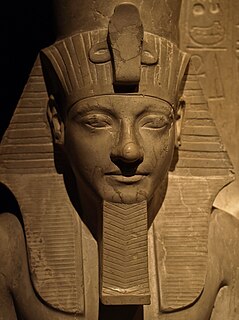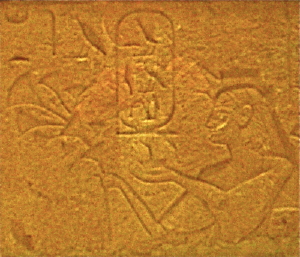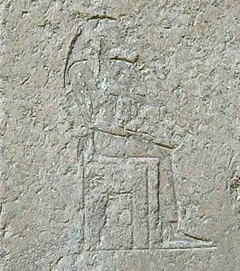
Khufu was an ancient Egyptian monarch who was the second pharaoh of the Fourth Dynasty, in the first half of the Old Kingdom period. Khufu succeeded his father Sneferu as king. He is generally accepted as having commissioned the Great Pyramid of Giza, one of the Seven Wonders of the Ancient World, but many other aspects of his reign are poorly documented.

Khafra was an ancient Egyptian king (pharaoh) of the 4th Dynasty during the Old Kingdom. He was the son of Khufu and the throne successor of Djedefre. According to the ancient historian Manetho, Khafra was followed by king Bikheris, but according to archaeological evidence he was instead followed by king Menkaure. Khafra was the builder of the second largest pyramid of Giza. The view held by modern Egyptology at large continues to be that the Great Sphinx was built in approximately 2500 BC for Khafra. Not much is known about Khafra, except from the historical reports of Herodotus, writing 2,000 years after his life, who describes him as a cruel and heretical ruler who kept the Egyptian temples closed after Khufu had sealed them.

Horemheb, also spelled Horemhab or Haremhab was the last pharaoh of the 18th Dynasty of Egypt. He ruled for 14 years somewhere between 1319 BC and 1292 BC. He had no relation to the preceding royal family other than by marriage to Mutnedjmet, who is thought to have been the daughter of his predecessor Ay; he is believed to have been of common birth.

Tuya was the wife of Pharaoh Seti I of the Nineteenth Dynasty of Egypt and mother of Tia, Ramesses II, Nebchasetnebet, and perhaps Henutmire.

Neferkauhor Khuwihapi was an ancient Egyptian pharaoh of the Eighth Dynasty during the early First Intermediate Period, at a time when Egypt was possibly divided between several polities. Neferkauhor was the sixteenth and penultimate king of the Eighth Dynasty and as such would have ruled over the Memphite region. Neferkauhor reigned for little over 2 years and is one of the best attested kings of this period with eight of his decrees surviving in fragmentary condition to this day.

Meryatum was an ancient Egyptian prince and High Priest of Re, the son of Pharaoh Ramesses II and Nefertari.

Prince Ankhhaf was an Egyptian prince and served as vizier and overseer of works to the Pharaoh Khufu, who was Ankhhaf's half-brother. He lived during Egypt's 4th Dynasty.

Queen Meresankh III was the daughter of Hetepheres II and Prince Kawab and a granddaughter of the Egyptian pharaoh Khufu. She was the wife of King Khafre.
Nebemakhet was a king's son and a vizier during the 4th Dynasty. Nebemakhet was the son of King Khafre and Queen Meresankh III. He is shown in his mother's tomb and in his own tomb at Giza.
Meritites I was an ancient Egyptian queen of the 4th Dynasty. Her name means "Beloved of her Father". Several of her titles are known from a stela found at Giza. She was buried in the middle Queen’s Pyramid in Giza.
Djedefhor or Hordjedef was a noble Egyptian of the 4th Dynasty. He was the son of Pharaoh Khufu and his name means "Enduring Like Horus".

Kawab is the name of an ancient Egyptian prince of the 4th Dynasty. He was the eldest son of King Khufu and Queen Meritites I. Kawab served as vizier and was buried in the double mastaba G 7110–7120 in the east field which is part of the Giza Necropolis.

Meresankh II was a Queen of Egypt who lived during 4th Dynasty.

Khentkaus I, also referred to as Khentkawes, was a royal woman who lived in ancient Egypt during both the Fourth Dynasty and the Fifth Dynasty. She may have been a daughter of king Menkaure, the wife of both king Shepseskaf and king Userkaf, the mother of king Sahure. Some suggest that she was the regent for one of her sons. Perhaps, in her own right, she may have been the king of Upper and Lower Egypt, which aspects of her burial suggests. Her mastaba at Giza – tomb LG100 – is located very close to Menkaure's pyramid complex. This close connection may point to a family relationship. Although the relationship is not clear, the proximity of the pyramid complex of Khentkaus to that of king Menkaure has led to the conjecture that she may have been his daughter.
Duaenre was a vizier under Menkaure during the Fourth Dynasty of Egypt. His titles include those of king's son of his body, hereditary prince (jrj-pat), count (HAtj-a), vizier (tAjtj), scribe of the divine book, mouth of Nekhen, and mouth of every Butite.
Iunmin was a vizier from the Fourth Dynasty of Egypt. He was possibly a son of king Khafre. He served as vizier towards the end of the dynasty, possibly during the reign of his brother Menkaure.
Iunre (Yunre) was an ancient Egyptian prince of the 4th Dynasty. He was the son of king Khafre. He was named after Ra.
Ankhmare was an ancient Egyptian prince and vizier of the 4th Dynasty. His titles include king's eldest son of his body, as well as chief justice and vizier. Ankhmare was a son of Pharaoh Khafre and was named after god Ra.
Rekhetre was an ancient Egyptian queen from the late 4th Dynasty or early 5th Dynasty. She was a daughter of Pharaoh Khafra. Her husband is never mentioned, but Rekhetre would have been the wife of one of Khafre's successors, possibly Menkaure.
Sekhemkare was a vizier from the Fifth Dynasty of Egypt. He was a son of king Khafre and queen Hekenuhedjet. He served as vizier during the beginning of the next dynasty, during the reigns of Userkaf and Sahure. Sekhemkare is the only son of Khafre, whose death can be fairly securely dated to a precise reign, here that of Sahure.











